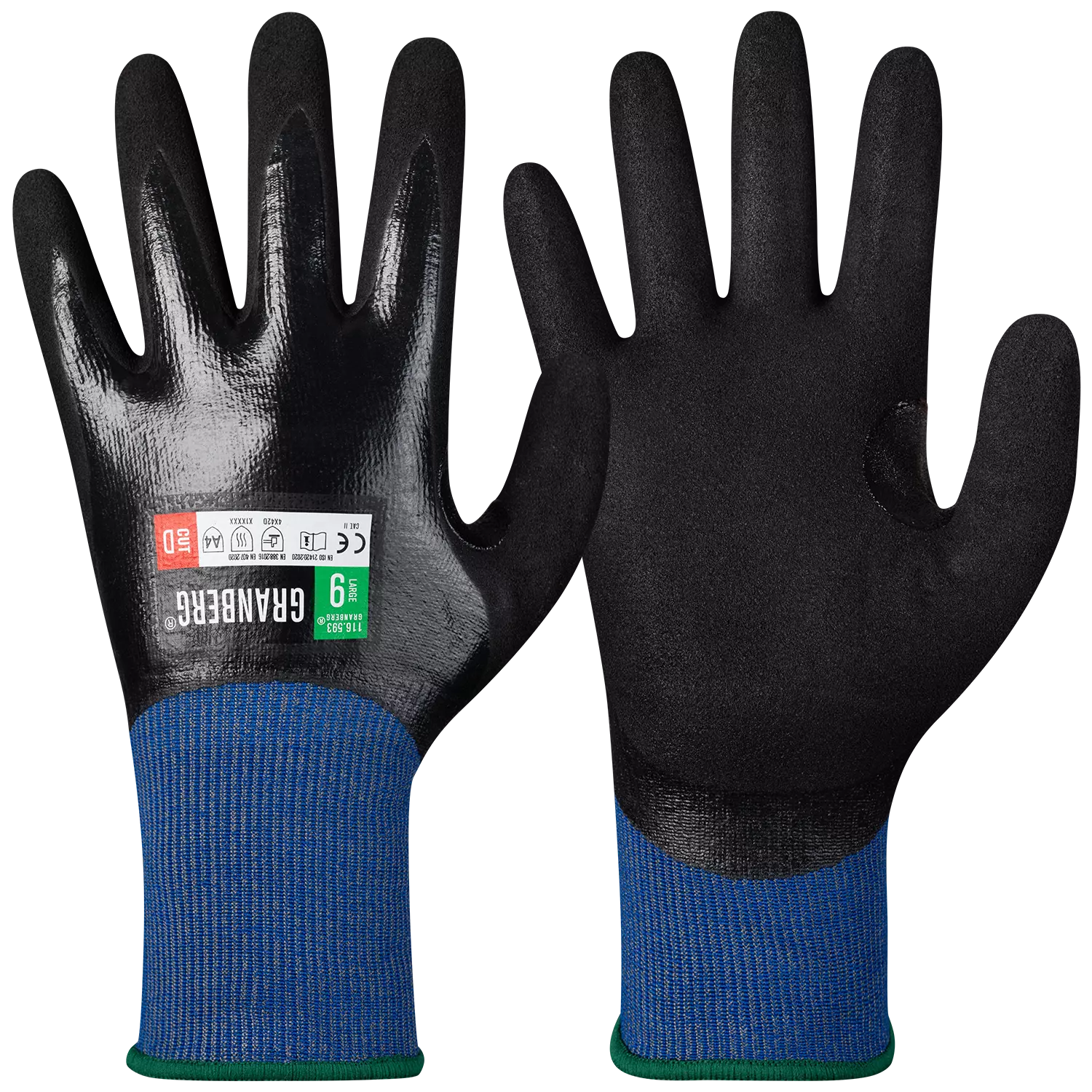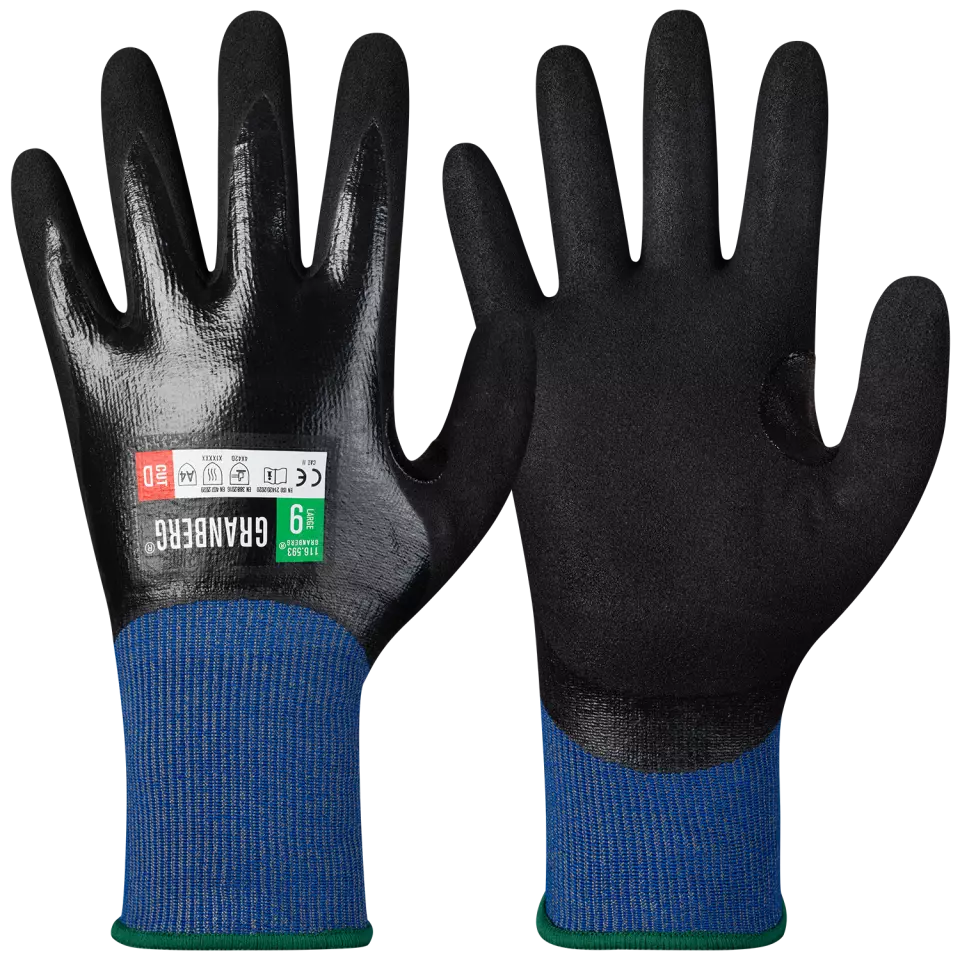
Features You'll Love

Cuff Style · Knit
Determines how the glove secures around the wrist, affecting fit, comfort, and protection coverage at the wrist area.

Grip Finish · Sandy
Coating Coverage · Fully Coated
The surface texture or coating on the palm and fingers that determines how securely you can grip objects while wearing the gloves.
Complete hand protection and enhanced grip give you maximum confidence and safety when handling materials.

EN 388 · Tear Resistance Level 4, Puncture Resistance Level 2, Cut Resistance, ISO 13997 Level D, Abrasion Resistance Level 4
EN 407 · Molten Metal Resistance Level X, Heat Contact Level 1, Heat Convection Level X, Radiant Heat Level X
Offers the highest level of protection against tearing, withstanding a strong force before ripping.
Withstands moderate force from sharp objects like heavy-duty splinters or wires.
Offers strong protection against cuts from utility knives, glass edges, and sheet metal.
Offers the highest level of protection against intense rubbing and wear from rough materials.
This product has not been tested for resistance against splashes of molten metal. It provides no claimed protection and should not be used for welding, foundry work, or other tasks with molten metal risks.
Provides protection when briefly touching hot objects. Certified for contact with surfaces up to 100°C for at least 15 seconds, offering short-term protection against burns from items like hot cookware or machinery parts.
This product was not tested for protection against convective heat, which is the transfer of heat through moving air, such as from a flame. Therefore, it has no claimed performance level for this specific thermal risk.
This product was not tested for protection against radiant heat, which is intense heat that can be felt from a distance. It does not claim to offer protection for tasks involving prolonged exposure to radiant heat sources.
Granberg
Ultralight, fully coated Cut-Resistant Gloves, Black/Blue, 12 pairs
Ultralight, fully coated Cut-Resistant Gloves, Black/Blue, 12 pairs
5 / 5
87,49 €
Price per 12 pairs
7,29 € / pair
Choose size
Free delivery
Features You'll Love

Cuff Style · Knit
Determines how the glove secures around the wrist, affecting fit, comfort, and protection coverage at the wrist area.

Grip Finish · Sandy
Coating Coverage · Fully Coated
The surface texture or coating on the palm and fingers that determines how securely you can grip objects while wearing the gloves.
Complete hand protection and enhanced grip give you maximum confidence and safety when handling materials.

EN 388 · Tear Resistance Level 4, Puncture Resistance Level 2, Cut Resistance, ISO 13997 Level D, Abrasion Resistance Level 4
EN 407 · Molten Metal Resistance Level X, Heat Contact Level 1, Heat Convection Level X, Radiant Heat Level X
Offers the highest level of protection against tearing, withstanding a strong force before ripping.
Withstands moderate force from sharp objects like heavy-duty splinters or wires.
Offers strong protection against cuts from utility knives, glass edges, and sheet metal.
Offers the highest level of protection against intense rubbing and wear from rough materials.
This product has not been tested for resistance against splashes of molten metal. It provides no claimed protection and should not be used for welding, foundry work, or other tasks with molten metal risks.
Provides protection when briefly touching hot objects. Certified for contact with surfaces up to 100°C for at least 15 seconds, offering short-term protection against burns from items like hot cookware or machinery parts.
This product was not tested for protection against convective heat, which is the transfer of heat through moving air, such as from a flame. Therefore, it has no claimed performance level for this specific thermal risk.
This product was not tested for protection against radiant heat, which is intense heat that can be felt from a distance. It does not claim to offer protection for tasks involving prolonged exposure to radiant heat sources.
Product description
These high-performance protective gloves combine superior cut resistance with exceptional dexterity through their innovative 18-gauge Typhoon® HPPE liner and full sandy nitrile coating. Achieving EN 388:2016 cut level D and ANSI A4 ratings, they deliver comprehensive protection against mechanical hazards while maintaining excellent tactile sensitivity. The double-dipped coating technology ensures superior grip performance across dry, wet, and oily conditions, while offering outstanding protection against liquids and contaminants.
Product Features:
- Ultralight 18-gauge design for superior dexterity
- Double-dipped sandy nitrile palm coating
- Reinforced thumb crotch for enhanced durability
- Touchscreen compatible
- Oil-repellent properties
Technical Details:
- Typhoon® HPPE liner construction
- Full nitrile coating
- Level 4 abrasion resistance
- Level 4 tear resistance
- Level 2 puncture resistance
- Cut resistance: Level D (EN 388:2016)
- ANSI cut level: A4
- Contact heat: Level 1
Recommended Applications:
- Waste Management and Recycling
- Mechanical and Automotive Industries
- Construction and Metalworking
- Glass Handling
- Engineering and Manufacturing
- Utilities and Maintenance
- Oil and Gas Industry
- HVAC Work
Standards:
- CE Category II
- EN ISO 21420:2020
- EN 388:2016